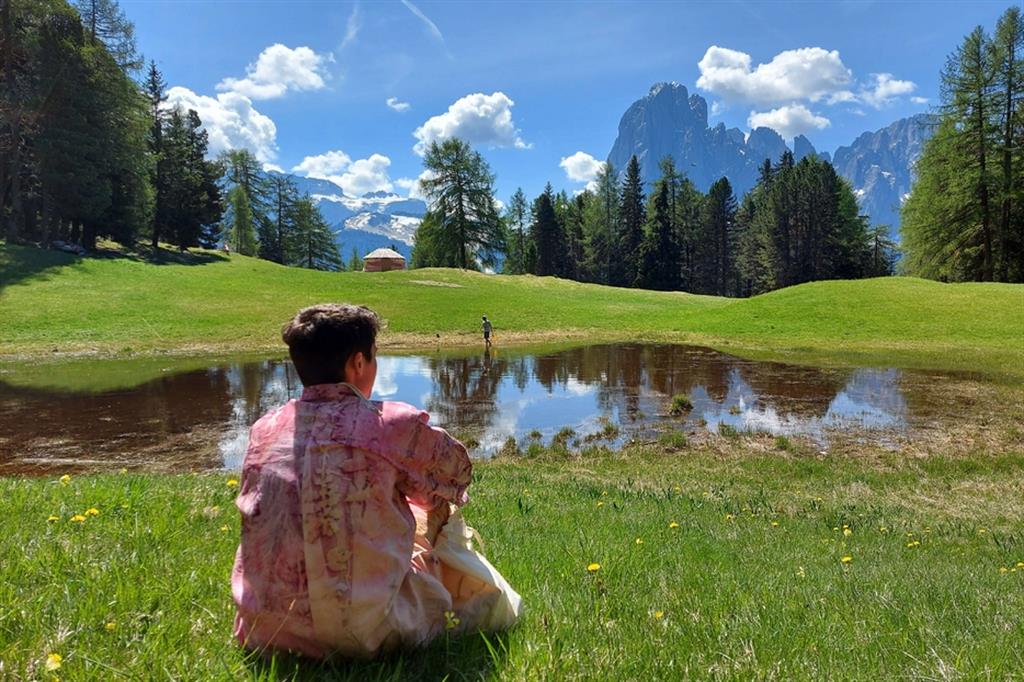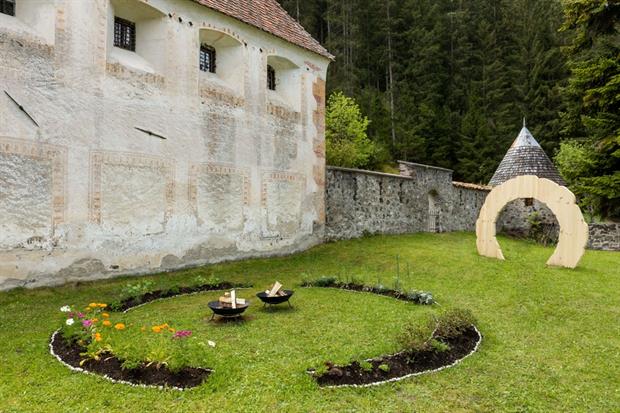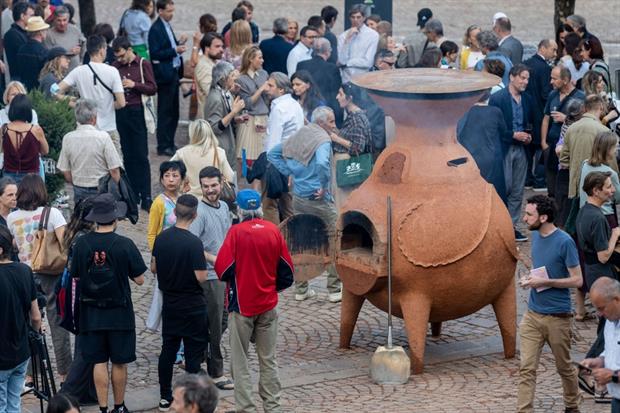
Alex Cecchetti, “Sentiero”, 2022. Work supported by the Italian Council – Alessandro Beltrami
The Dolomites are a unique phenomenon in the Alps also from a cultural point of view. Over the years, festivals have flourished (think of “Sounds of the Dolomites“), Museums at high altitude (above all Lumenon photography and mountains, at Plan de Corones) but also contemporary art initiatives, from Smacha land art biennial (organized in odd years) which in Val Badia has created a sculpture park, the Val dl’Ert; or again Contemporary Dolomitesbased in Cadore but with a wide range of action, which shifts the attention from nature (and above all its clichés) to focus critically on abandoned places, such as factories, tourist villages, schools, military architecture.
An important piece of this panorama is constituted by Biennale Gherdëina, which until 25 September is proposed with its eighth and most ambitious edition. With its center in Ortisei and with exhibition venues in other locations in Val Gardena, curated by Lucia Pietroiusti and Filipa Ramos, it is entitled “Persones Persons”: “The exhibition moves along two lines – explain the curators – The first takes into consideration the forms of personality, legal or otherwise, of nature and landscape, asking how artistic expressions can contribute to the recognition of the rights of the Earth and to the reduction of barriers. The other, reflecting on the practice of transhumance typical of Alpine areas, deals with ancient and future memories of the paths of people, animals, plants and materials ».
The title of the exhibition is significantly Ladin-English, just as the name of the event is Italian-Ladin. Gardena with Badia and Fassa is one of the three Ladin valleys, arranged in a crown around the Sella massif. We are in South Tyrol, the public speeches here slide seamlessly between three different languages. It is not just an obligation dictated by a susceptible one level playing field cultural. It is a historical dimension that today can give voice to an identity awareness that does not close in on itself but enhances the contribution of small countries to the democratic debate.
It is no coincidence that English was integrated into Ladin, German and Italian during the opening days and in the guide of the Biennale. The ambition is to accord a local language, in which investment, cultural but also political, has been strong in recent decades, and an international panorama. “It is far from obvious that an event of this type can be held in a mountain valley” explains Eduard Demetz, president of Zënza sëida (“Without borders”), an association committed to contemporary creation as a tool for growth and development in South Tyrol and promoter of the Biennale Gherdëina. “In rural areas we know that the relationship with contemporaneity is often marked by mistrust or fear. We are less used to meeting the new. We managed to communicate well and there is interest from the population. Furthermore, the artists were invited to get to know the culture and character of the Ladins, and to work with the help of the local artistic and artisan professionals ».
Similarly, the list of artists (35: there were 8 in the first edition) sees a group of artists from Val Gardena and South Tyrol such as Bruno Walpoth, Thaddäus Salcher, Barbara Gamper, Martina Steckholzer (some of whom work abroad) mixed with many others. Nationality. No Indian reservations. «On display there are all artists inserted in the languages of contemporaneity. At the same time, however, it is a Biennial of minorities. There is the Sami artist Britta Marakatt-Labba or the Karrabing Film Collective, made up of Australian aborigines, or Jimmie Durham, who was Cherokee. Or the artists who work on the uniqueness and fragility of the flora of these mountains ». Speaking is Doris Ghetta, founder and soul of the biennial. You are the owner of a gallery based in Ortisei and Milan, in whose rooms we find artists, such as Aaron Demetz, who have moved the centuries-old tradition of Val Gardena wood sculpture into the present, projecting it onto the Italian scene and beyond. A phenomenon of absolute importance and anything but obvious (but lucky enough to have generated a sort of modernist mannerism in the valley). “Many of these artists came from crafts and then studied in the academy, but we must think that alongside the production of sacred art and toys, based on historically defined models, along the twentieth century there is the significant experience of the Art School who tried to get sculpture out of serial repetition. What has changed? Until the 1990s and 2000s, the figurative was almost ignored on the international market. With the opening of Eastern Europe, great artists arrived who figured and suddenly the Val Gardena artists found themselves in line with the times ».

“Memory Garden” by Unknown, in Castel Gardena – Tiberio Sorbillo
This open system of global and local is not easy to manage (even from the visitor’s perspective) and not all of the Biennale Gherdëina, which presents the vices and virtues of a collective of contemporary art, has succeeded. The Trenker Room, the most traditional part of the exhibition, could be anywhere: better the headquarters of the Hotel Ladinia, a disused hotel, where Giles Round works with the theme of souvenirs and the tradition of wooden toys (whose enormous fortune is told at the Museum Gherdëina) while the Ghanaian Tabita Rezaire explores the art of doules, figures that accompany women on the path of motherhood. The context is grandiose but also dangerous: the installations in Vallunga, near Selva, are either completely out of place (the habitable flower, in concrete !, by Eduardo Navarro) or they get lost. The fascinating Castel Gardena, a hunting lodge between Santa Cristina and Selva open for the first time to the public, is instead the ideal habitat for Chiara Camoni’s shamanic creature or for the Memory Garden of Unknown, a circular garden that combines mnemotechnics, phases of the moon, processes of collective cultivation.
And it is the moments of participation that are the most successful, like the oven in adobe by Gabriel Chaile (also present at the Venice Biennale): inspired by his own family history and pre-Columbian art, it is both a sculpture in the center of Ortisei and a festive catalyst of conviviality; Marakatt-Labba, on the other hand, will close the exhibition with an embroidery workshop.

Gabriel Chaile’s “bread ceremony” during the inauguration of the Biennale Gherdeina – Tiberio Sorbillo
But the real gem of the Gherdëina Biennale is Pathway by Alex Cecchetti, project curated by Valerio del Baglivo and winner of the Italian Council. An intangible work on the spirituality of the forest, a walk in the heart of the forest off the slopes, alone with a performer-guide: a work that is more deeply rooted in the landscape, the lighter it is. No superstructure (if not a very fragrant final yurt, against the background of the Sassolungo), nothing that is not already present but that Cecchetti shows, hears and experiences in a new way. In summary, it is a tale. Faced with the prosopopoeia that marks other proposals, the artist reactivates the quintilianea prosopopeia, the ability to give voice to things and to put an invisible reality in front of the gaze and the other senses. The personality of the natural elements and the transhumance cease to be a theoretical framework to become experience. Of course, you have to believe it: it is the spell of the theater. But this wandering in the forest for endless turns on invisible paths to a dazzling clearing is a small miracle.
Art. Biennale Gherdëina: Dolomites and Ladins speak contemporary
